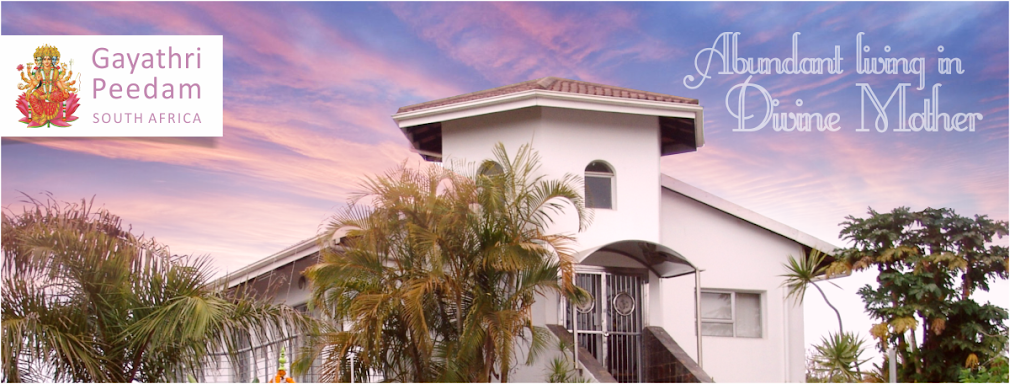Navarathiri Puja is a Hindu prayer that takes place over ten days and nine nights. Navarathri means ‘nine nights’ and is dedicated to the Female aspect of God, or the Universal Mother. The nine-day puja is separated into three parts, each carried out over three days. The first three days is set aside for Durga Devi, the next three days for Lakshmi, and the final three days for Saraswathi. Sometimes an extra day is added for the worship of all three deities.
The power behind creation is Shakthi (universal energy) in its three aspects: Durga, Lakshmi and Saraswathi. This power, we are assured by the Rishis (great sages), resides in each one of us. We have to invoke this Shakthi to assist us in reaching our ultimate goal which is realization of Oneness with the Divine Self in us.
Navaratri aptly starts on the first day after Amavasya, the New Moon day. The moon was steadily waning and reached its last stage of losing all the luster from the bright Sun. In Hindu mythology, the unsteady mind with its varying moods and modes is represented by the waxing and waning moon. In the ideal state, the mind must be always illumined by Divine Knowledge, represented by the Sun but, due to ignorance, we manage to cast upon it the dark shadow of our selfish ego which is bent upon fulfilling its worldly selfish desires. As a result, we progressively descend into the depths of spiritual darkness comparable to the full moon steadily declining over the fortnight into Amavasya or New-moon. Hope still exists because the Sun of knowledge continues to shine in the deep recesses of our hearts. We have only to know this, make a determination and reach it with great effort, overcoming the obstacles in the way caused by our misdirected ego.
This determination and effort is indicated by the commencement of the Navaratri celebration starting with the worship of Durga, invoking her Shakthi for the removal of the obstacles in our spiritual path; these obstacles were responsible for our decline into the lack-lustre new-moon mind-set. Mythology tells us that Durga is the One who destroyed the powerful demon Mahishasura (Mahisha = Bull; asura = demon, our undisciplined self). The Bull is characterized by great inertia and also great rage – a very apt model for our own ego. (Remember the bull in the china shop?) All our spiritual practices are hindered by inertia; we start, but soon stop, like the immobile bull on the street blocking all traffic. No wonder we make very little progress. We are also swayed by extreme passions like the enraged bull which then charges wildly. The slaying of this demon by Durga symbolizes the taming of this ego-bull and putting it to productive use in the service of God. Observe how the same bull under the total control of its master Shiva becomes Nandi who is worshipped – Nandi always faces the Lord and is eternally in His service. The Durga Shakthi, if invoked through prayer, will help us to yoke our ego and plow the spiritual field for us.
The next three days are devoted to the worship of Lakshmi. The yoked ego is now ready for Karma Yoga which ensures a dynamic life filled with selfless activity. This helps to cleanse the mind of selfish desires. Any action needs resources and Lakshmi is the provider of every resource needed by us. When you need courage, Dhairya Lakshmi provides it for you; Valor by Virya Lakshmi; material resources by Dhaanya Lakshmi and Dhana Lakshmi and so on: that is why Lakshmi in eight forms (known as Ashta Lakshmi) is worshipped. Whereas all the resources needed for Karma are provided by Lakshmi, we need Vidya (knowledge) and Viveka (power of discrimination) to use these resources in the right manner.
To make an intelligent choice, we need a well-informed mind: the education needed for this is given by Saraswathi whose Shakthi we invoke in the final three days of Navaratri. You may have seen in paintings of Saraswathi, a peacock rapturously listening to the music played on the Veena by the Goddess. When we pray to Saraswathi, she plucks our heartstrings from which divine music issues forth. Our ego, tamed and trained by the power of Durga and Lakshmi then starts listening to the dictates of the pure Intellect and the divine music of OM. The bull has been transformed into Nandi, ready to serve our spiritual purpose. Nothing then prevents us from proceeding further in the path of Self-Realization and reaching the ultimate goal of Sat Chit Ananda. (Reality-Consciousness-Bliss)
We are aware of the power of the untamed ego and how it can take us along the wrong path. Who would not therefore, celebrate ultimate victory in this battle and taming it for spiritual use? At the conclusion of nine days of prayer and meditation, we celebrate our spiritual victory on Vijayadasami day. (Vijaya = Victory; dasami = tenth day). On this day, students rededicate themselves to their study through formal recitations from their books and paying their respects to their Guru; professionals rededicate themselves to their work symbolically by worshipping the tools of their trade. Mentally, every devotee renews the determination to work towards the spiritual goal of Sat Chit Ananda.
Whatever our age, we are all students trying to learn Truth Reality in various ways. The Navaratri celebrations every year help us to invoke the divine power which resides in everyone of us and through the Grace of Shakthi, to proceed further on the path of self-realization with faith and renewed vigour to the ultimate goal of Sat Chit Ananda.
